|
10/30/13 – Bhutan to New Delhi
The wakeup call comes at the ungodly hour of 4:15 am. The group agrees not to have breakfast at the miserable hotel, but will wait for breakfast on the flight to New Delhi – bad choice. We end up with no breakfast at all. The flight from the Paro airport is delayed until the fog clears from over the Himalayans. Apparently this is a common occurrence for an airport nestled between two mountains.
We have a short one-hour flight to Calcutta and then change planes to fly on to New Delhi – that’s where the nightmare begins. In the Calcutta airport, the OAT group must stay together because our combined tickets are on a single piece of paper. Semmy is the leader and a natural born leader at that. However, Maryann, the problem child, picks up her luggage first and then dashes off ahead of us. She goes to an entry to the departure lounge and convinces the security person to let her through without a ticket (an absolute no no). The rest of us go to a different entry to the departure lounge and are told to wait until all 11 members (including Maryann) are present. We scatter about looking for Maryann, the 11th member, to gain our passage to the next flight to New Delhi. After much delay and much frustration, Bill and Woo finally track down Maryann. We make our flight connection with very little time to spare. It is not what we needed. Except for one member, who shall remain nameless, unless you can figure it out, it is a great group of folks, a group that goes with the flow and watches out for each other. I am honored to call these people my friends.
After a 2 hour flight (and a crappy, soggy cucumber sandwich which must pass for breakfast or lunch) we arrive in New Delhi. We are greeted by an OAT representative and then lead to Prahbu, our guide in India. We follow him to a nice, big, comfortable bus where the bus driver hands out cold bottles of water and gives us marigold lays. Being an older crowd, we joke about going to the Marigold Hotel Retirement home.
Prahbu is an experienced, knowledgeable guide and once led treks in the Himalayans. On our 10-mile drive from the airport to our hotel, I learn more about India than I ever learned in school. He tells us:
- India has the second largest population in the world – 1.2 billion, with China ahead at 1.3 billion. The population is both an asset and also a liability.
- India is the 7th largest country in the world in terms of land area. It is only 1/3 the size of U.S., but has 3 times the population of U.S.
- India has a 5,000 year old history, but has only been a democracy for 65 years.
- India is a religious country with many religions to choose from. However, it is highly influenced by the Hindus, who make up 80% of the population.
- 35% of the population is poor, really poor.
- The median age is 27 years old.
- Unemployment and poverty lead to social issues, but India is headed in the right direction to solve them.
Prahbu shifts his focus to New Delhi. He tells us the Mughals were here before the British took over in 1911. In an area that was only a farming village at that time, the British planned the new city of New Delhi to support a population of 200,000. Unlike Old Delhi, they put in wide roads, round abouts, trees, gardens and magnificent governmental buildings with stately homes and bungalows for the British officials. New Delhi now has a population of 22 million with very little space. Space in India is a big luxury.
New Delhi is building a massive underground metro which causes even more traffic jams now, but will be a good thing once it’s finished. The pollution, now much improved, is caused by the vehicles – cars, buses, etc. Most of the polluting industries have moved away. Now the buses run on CNG – Compost natural gas, which is helping solve the pollution problem – but the place still has a long way to go.
We pass by large military complexes; one barracks was left behind by the British. India, because of its unemployment problem is able to pick and choose the very best men for the military. Sometimes, 100,000 men apply for only 1,000 positions. They definitely get the best and the brightest.
Due to the high import tax, India imports very little. This is done to protect the country, but it can also cause big problems. For example, almost all cars and buses are built in India, but the quality and technology is not yet there. India is still a 3rd world country.
After driving through throngs of people -- many poor and begging -- we arrive at our 5- star Park Hotel and quickly forget about the poor and begging. With our Marigold lays, we have our welcome drink and wait in the lobby for our room assignments. Hey, how’d all this luxury happen to a poor girl from Texas? I enjoy the ritzy comfort of this fancy, high class place, but don’t feel quite at home. I’m not complaining, I’m rather be here than with my Indian brothers and sisters struggling just to survive on the crowded streets.

The Park Hotel, New Delhi |

The Park Hotel, New Delhi |
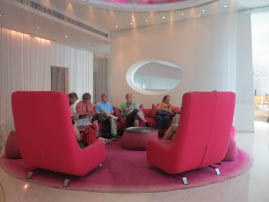
The Park Hotel, New Delhi |
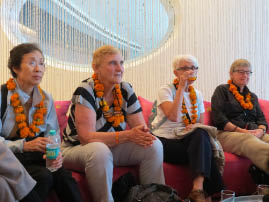
Kai, Ann, Maryann, Bran |
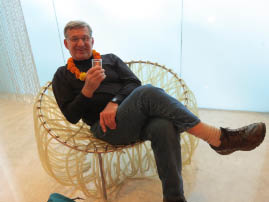
Semmy |
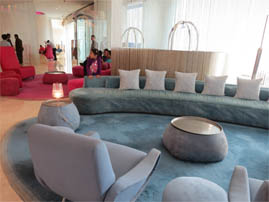
The Park Hotel, New Delhi |
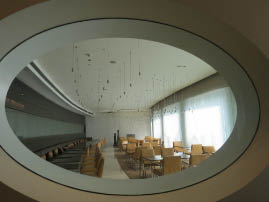
The Park Hotel, New Delhi |

The Park Hotel, New Delhi |
We go to our room, unpack, shower, and wash clothes. It’s been a hectic, long travel day. I decide to treat myself to a beer from the mini-bar – which I never do. The Kingfisher beer is not cold, so I go to the hotel bar and order one. Bill joins me later.
We met Prahbu at 5 for an evening walk to the Sikh temple. We wind our way through teaming masses on busy streets until we get to the temple. We go into a room, remove our shoes and put on a head dress. It’s very funny to see my colleagues, male and female, all sporting head scarves. We learn about the Sikh religion from Prahbu and a couple of Sikh leaders who seem relaxed and happy and having a good time. Here’s some of what we learned about Sikhism:
Sikh means “disciple” – a person who believes in One God and the teachings of the first 10 Gurus who established the religion. It is a new religion founded by Guru Nanak in 1469 A.D. in a village in Pakistan. He didn’t go along with all the meaningless rituals and superstitions that passed for religion in those days, so he started his own religion, with new meaningless rituals to pass along all the way to the 21st century (and counting). The men never cut their hair. They twist it and wrap it tightly and shove it under their turbans. They carry mini daggers to remind them of their fierce warrior tradition when they had to defend themselves from unspeakable persecutions from the Mughals. (Sikhs are profiled as great fighters and make up a large percentage of India’s current military.)
With our heads covered, we enter the temple grounds. The area is enormous – biggest Sikh temple in the world, I believe. There is a vast pool of water that people use to purify themselves before entering the temple. However their rules dictate that they can’t use the pool after the sun goes down.
Inside the temple, a main Sikh guy is reading from the holy book – Sikh Holy Scripture. Right before the tenth top Sikh guru in line died in 1708, he gathered all his teachings along with the cumulative teachings from the nine previous Sikh gurus and wrote them down in a holy book, eliminating the need for any future guru top dog. Every day at sunrise, the holy book is taken from a special room and a leader reads the text. At sunset, it is placed back in the room. A whole lot of worshippers find these words very moving and comforting and come by the droves to listen to them. The temple has no statues or paintings, but is magnificently decorated.
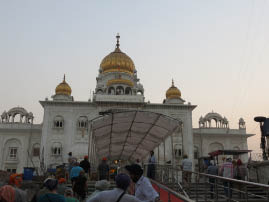
Gurudwara Bangla Sahib Sikh Temple |

Gurudwara Bangla Sahib Sikh Temple |
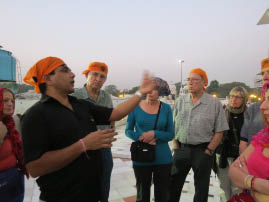
Gurudwara Bangla Sahib Sikh Temple |
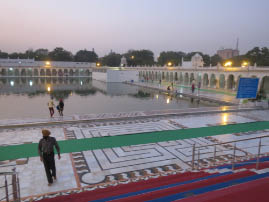
Gurudwara Bangla Sahib Sikh Temple |
The Sikhs believe everyone is equal, rich or poor, man or woman. They believe in helping others and serving the huddled masses. The temple feeds 15,000 people a day and everyone is welcome to join in the feast -- rich or poor, man or woman. Prahbu takes us downstairs into the massive kitchen to help prepare the evening meal – some help we are! I rolled out a couple balls of dough for the Naan bread. Everyone is happy and having a good time.
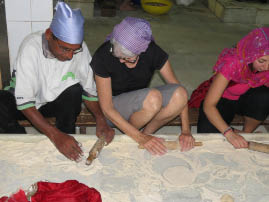
"Helping" to prepare meal at Sikh Temple |
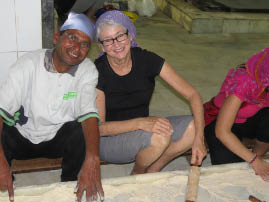
"Helping" to prepare meal at Sikh Temple |
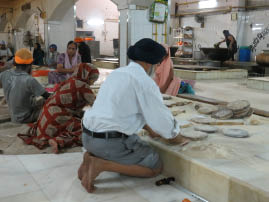
Preparing meal at Sikh Temple |
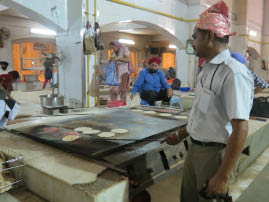
Preparing meal at Sikh Temple |
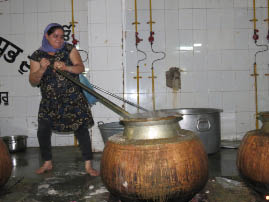
Preparing meal at Sikh Temple |
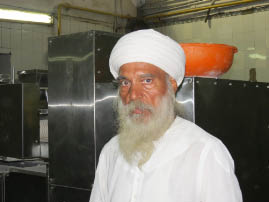
Preparing meal at Sikh Temple |
Our OAT buddies have a lot of fun at the temple. It is a fascinating experience. I now understand my wonderful friend Katy who comes from an India spiritual tradition. She loves to serve food to people and finds absolute joy in giving to others. I miss my friend. One temple had one major drawback – because no shoes are allowed in the temple, we leave with very dirty feet. Some of us even felt the fleas jumping up from the carpet and landing on our ankles. We try not to think about that too much.
We go to dinner with Woo and Kai and Brian and Tinker, the new guys from Tennessee, who just joined the group today. The restaurant, “Kwality,” just a block down from our hotel is excellent. We’re thrilled to start a new adventure in India. We come back to the room totally exhausted.
10/31/13 --New Delhi
I wake up at 5 and start working on my journal right away – so many things to report. It’s always a struggle keeping up.
At 7 we have a yummy breakfast at the hotel with all the cups of cappuccino one can hold. This is heaven. We check our email and learn that Zion made straight A’s, except for 2 A+’s in math and art. Our granddaughter is an amazing young lady – enough grandma bragging … back to India.
We have an orientation meeting with Prahbu. He tells us he worked for a company in Austria as a guide for trekkers in the Himalayans. He loved the work and loved the mountains. Then, one day in his late 20’s, he gets a phone call from his father that changed his life forever. The Dad told him to come home to get married. The parents found a bride for him. He goes home and marries and returns to his trekking job in the mountain. After a few years, Prahbu learns that life as a guide is difficult for a man with a wife and a family back home, so he finds a job as an OAT guide in India, to have more time with the family. He works 2 weeks and then has two weeks off. His sons are now 9 and 11.
In our meeting, Prahba fills us in on some do’s and don’ts in India and miscellaneous facts like:
- Begging is illegal in India. Don’t give anything to the children on the streets. A lot of the begging is part of organized crime.
- People here don’t want to say “No” to you. If you order a newspaper at the hotel desk and they don’t have one, they will say, “It’s coming,” because they don’t want to disappoint you.
- 50% of Indians are vegetarians. They substitute lentils in their diets to make up for the lost protein. Dahl is (made with lentils) is served at almost every meal. They get everything fresh – no frozen foods to be had so the vegetables available are the vegetables in season. (We always eat better in 3rd world countries -- everything is so fresh and good.) Cows are holy so beef is a No No. If people order meat, they are usually served water buffalo.
- India is the place for shopping and looking for bargains. Prahbu tells us that the shops he takes us to give us all 20% off. He and the driver get a commission as well – 5% for him / 3% for the driver. I’ve never heard such honesty in a tour guide in my life. Prahbu is a good guy.
Prahbu finishes the orientation talk leaving us an hour for lunch before we board the bus for our tour of Delhi. Bran and Ann go with us for a “Quick Lunch” at Kwality, the same place we dined the night before. We split a lunch and can’t eat it all – delicious. It was great getting to know Bran and Ann better. We all grow weary of the long table banquet type seating, so it’s nice to have a couple of friends to chat with – instead of 16!
At 1 pm, we leave in our big fancy air conditioned bus for Old Delhi. Prabha points out the long wide boulevards built by the British and then we cross into Old Delhi with the narrow alleyways packed with shops and houses and life everywhere. Old Delhi had been the seat of an empire for 500 years, when Bombay and Madras were just trading posts and Calcutta was a village of mud huts. Through the centuries, eight cities were built on this site – by Hindu, Mughal and British, all leaving their own flavor.
We pass by the famous Red Fort, built in the 1650’s by a very, very wealthy Mughal named Shah Jahan. It was a massive, impressive structure, but we’re not visiting it because we’ll see the fort in Jaipur, which is similar, only better.
We pass through more and more crowded streets lined with shops all busy selling anything one might want -- plus more, i.e., shops selling fireworks, statues and decorations (mostly strings of lights) for the upcoming Hindu Festival Lights – or Diwali. The celebration is on Nov. 3rd and honors Lord Rama, a warrior king who slayed demons. He brought the people out of the darkness into the light and for that, he deserves a big holiday.
From the comfort of our bus, I snap photos of the people going about their daily life on the streets of India. It is a visual feast. I am powerless over the need to document each scenes. (It appears Maryann has the same shutter finger affliction as me. We should form a support group.)

Old Delhi |
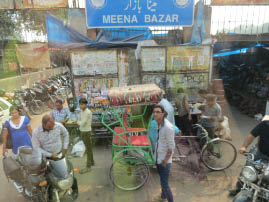
Old Delhi |

Old Delhi |
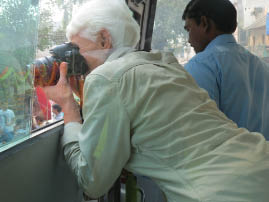
Old Delhi |
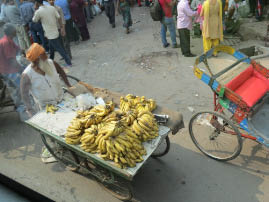
Old Delhi |
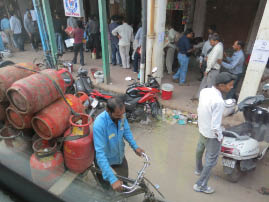
Old Delhi |
We park and exit the bus. We are now fully exposed to the real India and not protect by our bus or our guide. We cross the street of Old Delhi and walk up some very steep steps to enter India’s largest mosque, Jama Masjid. We remove our shoes and enter through Gate 1.
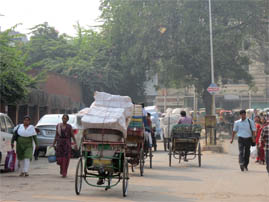
Driving to Old Delhi |
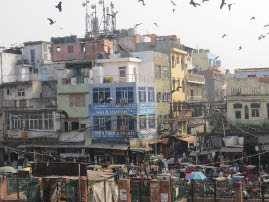
Delhi |

Jama Masjid |
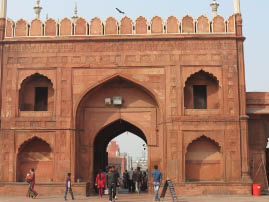
Jama Masjid |
Jama Masjid holds a mind-blowing 25,000 people. Just think that 25,000 people can pack in here for prayer and the entire mosque is outdoors. From 1644 to 1658, the same rich Mughal who built the Red Fort also built this mosque. It was Shah Janan’s final architectural feat. It has three gateways, four towers, two minarets (40 meters high) and is made of sandstone and white marble.
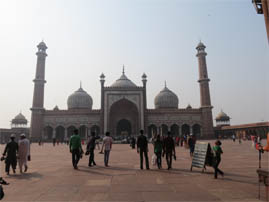
Jama Masjid |
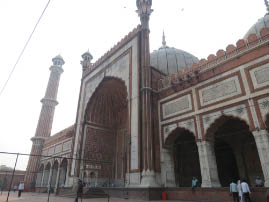
Jama Masjid |
Us OAT women put on robes, as required. We take photos and laugh at each other. We look like a bunch of old Russians gals. A gang of teens finds us entertaining. Us “old Russian hags” and the teens snap photos of each other. Everyone has a camera or a phone for picture taking – the newest form of communicating without language.
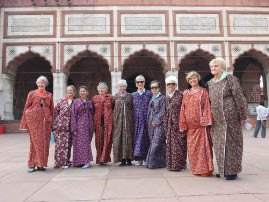
OAT women at Jama Masjid |
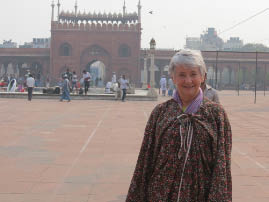
Nancy at Jama Masjid |
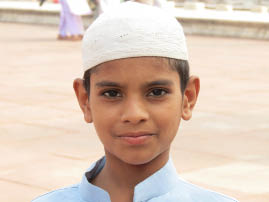
Boy at Jama Masjid |
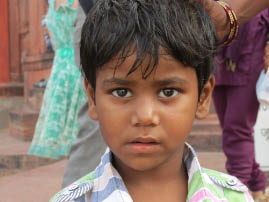
Boy at Jama Masjid |
There’s a large pool for people cleansing in the temple’s huge marble courtyard. I walk through the corridors of the temple and snap some photos of exotic people with interesting faces. They find us Westerners just as interesting. I take extra photos to justify the extra $6 fee for a camera. I see families scattered about the courtyard’s shaded areas, relaxing and having fun. Many people come from all over as a pilgrimage to Mecca.
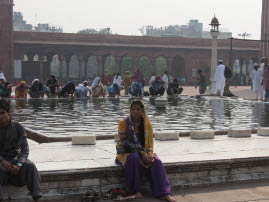
Jama Masjid |
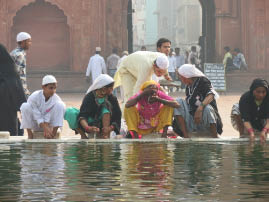
Jama Masjid |
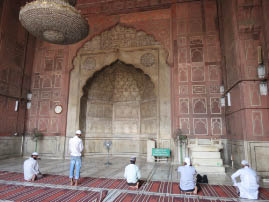
Jama Masjid |
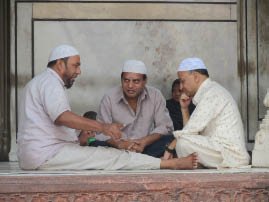
Jama Masjid |
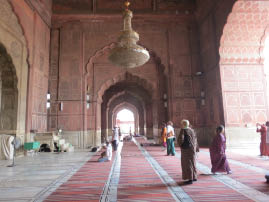
Jama Masjid |
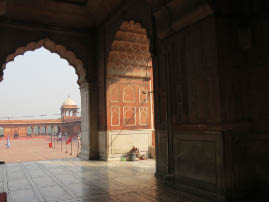
Jama Masjid |
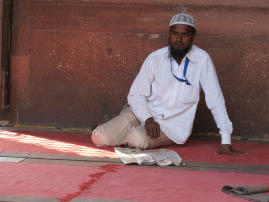
Jama Masjid |
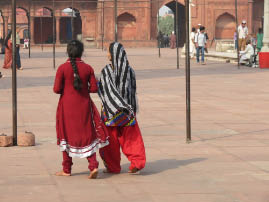
Jama Masjid |

Jama Masjid |
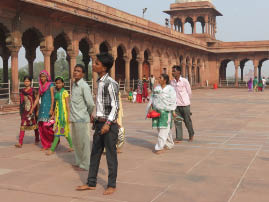
Jama Masjid |
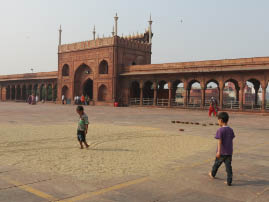
Jama Masjid |
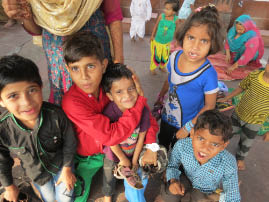
Jama Masjid |
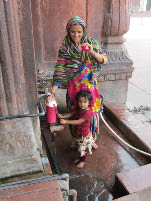
Jama Masjid |
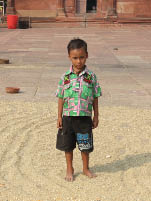
Jama Masjid |
We leave the Mosque and hop on rickshaws for a ride through Old Delhi on the crowded lanes of the Chandni Chowk bazaar. Our rickshaw driver is not strong, has a very crappy bike and can’t seem to judge distances very well so we collide with a couple of other rickshaws along the way. We stop to untangle the wheels and then carry on after the drivers exchange harsh words. The streets are packed. It is impossible to take it all in – life is swirling all around. I hear a loud voice crying out and look down to see a man propped up in the middle of a narrow lane, in a most pitiful body. I make myself look and realize he is a leper. My friend Katy finds great joy in helping lepers in India. Katy looks beyond their horrific bodies to see their beautiful souls – so I take a good look at the man, searching for his soul. I see a powerful spirit because he has a powerful voice and such a strong will to survive. Given his condition, I would have given up on life long ago.

Old Delhi |

Old Delhi |
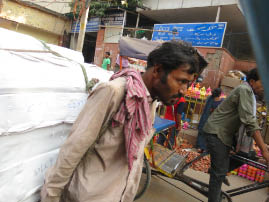
Old Delhi |
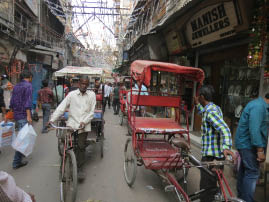
Old Delhi |

Old Delhi |

Old Delhi |

Old Delhi |

Old Delhi |
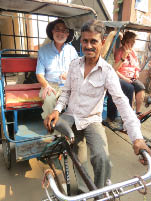
Old Delhi |

Old Delhi |
We end our rickshaw experience and climb back on the bus. Prahbu runs a commentary, pointing out life in Old Delhi. We see blocks of auto parts, all sorted for recycling. We see goats to be sold and sacrificed at the temple we just visited. We see all kinds of people cooking wonderful street food. Prahbu said it is delicious, but if we have it, it will be our last supper. And, of course, there is the ever present beggar who always seems to be the loneliest person in town. The images are etched into my brain.

Old Delhi |

Old Delhi |

Old Delhi |

Old Delhi |
Our last stop for the day is Raj Ghat, a serene, simple monument built where Mahatma Gandhi was cremated – The Father of India and my personal hero. The simple granite slab is in the center of a lovely park. People come to enjoy the park and honor their great leader.

Raj Ghat |

Raj Ghat |
School is just letting out when we arrive. The kids, most in middle school, are fascinated by our group of aging WASPS. They join us while Prabhu is telling us the story of Gandhi. They want their pictures taken. The bold ones shake our hands while the shy ones only stare at us. Although they wear tattered school uniforms, their beautiful dark skin, big brown eyes and wide smiles with perfect white teeth shine through and touch our hearts. Finally Prahbu must shoe them away so he can finish his story about Gandhi.

Kids at Raj Ghat |

Kids at Raj Ghat |
Gandhi was born in western India along the coast, to a well-to-do family. He was sent to England to be educated and went to South Africa for a time to help with the family business. One day changed the whole direction of his life. He was traveling on a train, dressed in his proper English suit and tie, but was thrown off the train because of the color of his skin. He felt not only discrimination for himself, but for all the Indian people. He took two years off to travel around Indian and get to know what his fellow countrymen experienced. In 1917, I believe, he entered parliament and in just 6 years, was the guy in charge. His approach to “right the wrongs” was non-violence – a very brave approach. He said how many people can the British kill? And sure enough, after the British had killed enough “disobedient” Indians, they became frustrated and finally packed up their bags and left. The press also helped the process by revealing to the world the classic “good versus evil” scenario.

Once India gains freedom from the Brits, Gandhi must settle an internal dispute -- which ends up with Pakistan separating from India with a big hunk of land. Some Indian people were angry and thought Gandhi was giving up too much to Pakistanis in the deal. In January 30, 1948, an Indian man came to the garden where Gandhi said his evening prayers and assassinated him. The man was tried and hung 6 years later. A crowd of a million came to Gandhi’s cremation sight to say good-bye. We are now at a beautiful park that surrounds the memorial. All the other Indian prime ministers and leaders must now settle for a simple memorial, not to outdo Gandhi. I was moved by the peacefulness of the area.

Gandhi Memorial |

Gandhi Memorial |

Gandhi Memorial |

Gandhi Memorial |

Gandhi Memorial |

Gandhi Memorial |
We get back to the hotel about 5. I work on the journal and then join the group in the lobby for the best dinner I have ever had in my life. We went to a place called Zaffron Ė every dish was yummy. Fat and happy, we walk back to the hotel. I walked back with Judy. Because of her broken ankle and screwed up knee, we lag behind at the back at the pack. We are clear prey for all the predators either begging or stealing or trying to sell us anything. The little girls are the biggest nuisance, patting our butts, doing anything for attention. We put on our scowls and hardened our hearts and move through the mobs. Luckily we didnít have purses so there was nothing to nab. I wish it didnít have to be this way.
11/1/13
New Delhi
After breakfast, we board the bus for our day of exploring Delhi. From the comfort of my big air conditioned bus, I watch the amazing scenes that pass below my window. I see the city waking up Ė beggars on the street beginning to stir and dogs chasing a monkey up a tree. Such a different world.
Our first stop, Qutab Minar, is in the far south of the city. This ancient complex was built in the 12th century and now is an UNESCO World Heritage site and the symbol of Delhi. Itís a spectacular example of Indo-Islamic architecture. The entire complex was once a grand 'city center' and includes the ruins of India's very first mosque and a series of tombs and mausoleums.
The Qutab Minar is the main attraction Ė a giant tower that stands 238 feet tall. It was built as a minaret to call the faithful to prayer at the nearby mosque. The outside of the tower is decorated with calligraphy and geometric carvings -- no figures allowed here. At the base it's 40 feet in diameter tapering to just 9 feet at the top. The spiral staircase with its 379 steps is housed inside of the tower. We didnít climb up because there is no railing on the top balcony. A few years ago several people in a pushy crowd, were killed by falling off. That ruined it for all of us.

Qutab Minar |

Qutab Minar |

Qutab Minar |

Arriving in Paro |
The tower was built by a famous king named Qutab din Aibak. He was sold as a slave in his childhood to the royal family. He showed great promise and was “loyal” – so he became “royal” as well. He was the first Sultan in Delhi. His ruler-ship was short lived. He died relatively young in a polo match.
The tower was probably built as a victory memorial to celebrate the Muslims taking of Delhi from the Rajputs (Hindus) - in the days of a Hindu majority in India. Prahbu explained that once the new guys (Muslims) took charge, they had to show the locals how rich and powerful they were to intimidate the locals and keep all that they had gained in war. Building towers that dominate the skyline was one way of sublimating on a grand scale. It took more than 150 years to build the complex. Three rulers were involved, each adding their own style to the successive levels.
There are stories of pride and ambition behind these ruins. The tower was to be the only the first, small effort in a large complex. On the far side of the complex is the much greater start of the second tower, which would have been twice the size of the first. The second tower only made it to about 18 feet above the ground. The then king, Alau'd din Khalji, got sick and his supporters and successors didn't share his vision for an even bigger tower, so the project ended.

Unfinished second tower at Qutab Minar |

Qutab Minar |
While the tower is the main attraction, there are many other buildings on the site along with several interesting tombs. A giant wall of arches decorated in Koranic verses is part of a mosque. The architecture elements were eye-popping -- incredibly detailed lattice-work, delicate screens carved of red sandstone (to lower the room temperature) and lotus flower designs.

Qutab Minar |

Qutab Minar |

Qutab Minar |

Qutab Minar |

Qutab Minar |

Qutab Minar |

Qutab Minar |

Qutab Minar |
When the British ruled years later, they added their own touch to the place, leaving behind some of their artifacts -- including a sun-dial and Smith's Folly. Sanderson’s Sundial was erected in memory of one of the Superintendents of the Archaeological department who conducted extensive excavations at the complex. Smith’s Folly is a strange pink canopy that was once placed on top of the tower.

Sundial |

Smith’s Folly |
Many of the pillars had been plundered from up to 27 Hindu temples that had been destroyed in the area. In the courtyard stands one of the mysterious iron pillars that never rust. Apparently there are several of these in the Delhi area and they are much older than the rest of the site. The pillar carries an inscription dedicating it to the god Vishnu and to Chandragupta the second, a 4th Century leader.

Iron pillar that never rusts |

Iron pillar that never rusts |
We strolled around the magnificent grounds, visiting the tombs, and imagining just what this place must have been like back in the days when the Muslims first came to power.
Our next stop is at the Cottage Industries Exposition, billed as a place to demonstrate how cashmere carpets from Afghanistan are handmade – but whose real intent is for you to BUY. The routine is the same. We are invited to sit down in a lovely showroom and offered very nice tea and cookies. Then the main carpet spokesman takes center stage. This one is perfect in his role. With intense eyes, he weaves magnificent stories. He tells how he learned the craft of carpet weaving from the family in a little village in the shadow of the mountains of Afghanistan. He has our complete attention. He takes a lighter to demonstrate how to finish off the carpet by burning the nap -- a wonderful climax. Then comes the carpet guys unrolling beautiful works of art. The carpets are much too rich for our blood, but Semmy and Jan buy a beauty. I am glad because I know Prahbu and the driver will get a pretty penny from the sale.

Would you buyta used carpet from this man? |

Beautiful Carpets |
We dine at a very nice restaurant in the embassy neighborhood called Garam Masala - very stylish dishing up excellent food. We wash it down with a Kingfisher beer – Life is grand in India.

Dinner with Kingfisher |
After lunch we head back out to see the highlights of New Delhi. The British laid out the broad tree-lined avenues and neat street grid of New Delhi, in stark contrast to the narrow, winding alleys cramped streets of Old Delhi. Today the former “Imperial City” continues as the center of government for India, the world’s largest democracy. We drive by the buildings of parliament and see the residence of India’s President (a palatial building called Rashtrapari Bhavan). After 9/11, no one is allowed to visit. India is very big on security. We also drive through the India Gate and the large surrounding park. The gate is a memorial to the Indian soldiers who served in Great Britain’s World War I and Britain’s 19th century war in Afghanistan.

Parliament |

Parliament |

Residence of India’s President |

Residence of India’s President |

India Gate |

Prabu, our guide |
Although it wasn’t on our itinerary, Prahbu takes us to visit the place (now a museum) where Mahatma Gandhi spent the last 144 days of his life and was assassinated on January 30, 1948. It was originally the house (called bungalow) of an Indian business tycoon -- the Birla family. Gandhi was a guest of theirs at the time of his death.
Inside the museum is the place where Gandhi lived (and died). We see his simple room and his few possessions, like his glasses, watch and walking stick and a strange little statue of the 3 monkeys – see no evil, hear or evil or speak no evil. There are also many photographs, and sayings from his lifetime. Outside is the peaceful garden. We follow Gandhi’s footsteps on his way to his evening prayer and see the spot where he was assassinated. The experience is very powerful, leaving me with an incredible feeling of peace and spirituality. Thank you, Prahbu, for sharing this place – a place where an amazing human being once lived. It is humbling to see how Gandhi lived and how much he accomplished.

Gandhi Museum |

Gandhi Museum |

Gandhi's room before he died |

Gandhi Museum |

Gandhi's last steps |

Gandhi Museum |
For dinner, we take the bus to have Chinese food at place called the Rice Bowl. We enjoy the meal – and are especially happy to have a different cuisine.
Prahbu gives us the option of riding the bus back to the hotel, or riding the subway. Bill leaps at the chance to check out India’s mass transit system and before long, almost all of the group wants to ride the subway as well. Prahbu buys our ticket and leads us down into the underground through the mass of humanity to our train. Men ride on one car – women on another. At one point, the women, led by me, interpret the signals from the guys in the car behind that we are to disembark. The gals get off at the next stop and quickly realize the error of our ways. We jump back on the car just in the nick of time with lots of good laughs on that ride back to the hotel. Prahbu – thanks for having the courage to guide a bunch of goofy Americans on an adventure in the underground.
11/2/13 – Overland to Jaipur
After an early breakfast, we climb aboard the bus to head to Jaipur, the capital of Rajasthan. It’s located in semi-desert lands of Rajasthan.

The bus to Jaipur |
It is smoggy and foggy and I can’t see shit – except for 260 kilometers of packed roads – mostly packed with big trucks – funny and exciting and scary all at the same time.

The road to Jaipur |

The road to Jaipur |

The road to Jaipur |

The road to Jaipur |
We stop at a MacDonald’s for a bathroom break. It’s a cool looking MacDonald’s. I suppose the posters inside are there to teach the little Indian kids how to whine like their American counterparts. (Thinking the meat is from water buffalo, no one in our group orders a burger.)

Indian Mac Donalds |

Indian Mac Donalds |

Indian Mac Donalds |

Indian Mac Donalds |
The driver stops the bus to buy some bananas to feed some monkeys along the roadside. Apparently, feeding the animals will bring blessings to you. (I’m just not crazy about monkeys.)

Monkeys by the road |

Monkeys by the road |

Monkeys by the road |

Monkeys by the road |
We stop in a town called Shahpura – Shah means “king” and pura means “town.” The place is hopping and alive with all the Diwali (Festival of Lights) activities going on. We get off the bus and board a couple of jeeps waiting for us. The jeeps take us up the narrow streets of town. We have several traffic jams along the way. From our jeep, we see what life is like in this little rural town. I can’t seem to get enough photos.

Backstreets in Shahpura |

Backstreets in Shahpura |

Backstreets in Shahpura |

Backstreets in Shahpura |

Backstreets in Shahpura |

Backstreets in Shahpura |

Backstreets in Shahpura |

Backstreets in Shahpura |

Backstreets in Shahpura |

Backstreets in Shahpura |

Backstreets in Shahpura |

Backstreets in Shahpura |

Backstreets in Shahpura |

Backstreets in Shahpura |

Backstreets in Shahpura |

Backstreets in Shahpura |

Backstreets in Shahpura |

Backstreets in Shahpura |

Backstreets in Shahpura |

Backstreets in Shahpura |

Backstreets in Shahpura |

Backstreets in Shahpura |

Backstreets in Shahpura |

Backstreets in Shahpura |
We drive uphill, above the little town, and then enter the Shahpura Haveli (means hotel). The Shahpura Haveli is the ancestral home of the Shekhawat family and has been in the family for over 500 years. The family’s ancient fortress is high above the hotel. The family recently opened it as a hotel and restaurant. The rooms are beautifully decorated with exquisite murals, mosaic and period furniture. We are thrilled to have lunch in such an elegant place, high above the masses in the streets.
After lunch, we ride the jeeps back to the bus. The bus takes us another two hours down the road to Jaipur and our hotel Sarovar Portico. We settle into our rooms and get ready for the evening.
For an extra treat, Prahbu takes us into Jaipur, also popularly known as the Pink City. On the way in, we see influence of British everywhere – large parks, Prince Albert’s palace with wide boulevards.

Jaipur |
We get off the bus in central Pink City (Jaipur). It’s Friday and the eve of Diwali – The Festival of Lights –where craziness abounds. We walk down the main street in single file weaving through the crowds. We are on sensory overload with noise, smells, cows, marigolds vendors, lights, candles, and fireworks (Cock Brand). I step in crap – hope it’s dog pooh, but one never knows for sure.
At the end of one block, Prahbu doubts that we can all make it back to the bus so he orders rickshaws for each of us. On the ride back to the bus, the rickshaws carrying Ann, Bran and Woo and Kai get lost. We track them down at Prince Albert’s palace – with lots of good laughs.
We arrive back at the hotel in time for Bill to do the laundry – and me to do the journal. (Exciting evening – however, I don’t recall where we had dinner.)
11/3/13 – Jaipur – Amber Fort / Palace of the Winds
Another glorious day. After a lovely breakfast, we leave our hotel, bidding “Good Day and Happy Diwali to the door man. We board the bus and find it decorated for Diwali – which makes the day even more special.

Sarovar Portico Hotel |

Sarovar Portico Hotel |

The Diwali Bus |

The Diwali Bus |
We retrace our steps back to Jaipur where we visited last night – but this time we see it in sunshine. The city is not really pink – actually, it’s closer to the color of terra cotta. When the Prince of Wales was scheduled for a visit back in 1876, the maharaja ordered the entire old city painted pinkish orange – the traditional color for hospitality. It looked so good he made it a law and the city remains that same beautiful color. Every year monsoon rains wash the color away so all the buildings are repainted annually using the same paint they used in 1876. The colors on the old buildings are vibrant.

Jaipur |

Jaipur |

Jaipur |

Jaipur |

Jaipur |

Jaipur |
Jaipur consists of two totally different towns: New and Old. A new one is a modern city with business centers and billboard advertising. The roads of the old town are taken over by elephants, camel carriages, and monkeys flying over the roofs of 300-year old buildings. When I passed through the entry gates of the Old City, I really felt like I am a passenger in a time machine.

Old Jaipur |

Old Jaipur |
We see busy streets filled with people buying decorations and fireworks and marigolds for tonight’s big celebration. Diwali is like our Christmas – and the streets are loaded with lots of last minute shoppers.

Streets of Old Jaipur |

Streets of Old Jaipur |

Streets of Old Jaipur |

Streets of Old Jaipur |

Streets of Old Jaipur |

Streets of Old Jaipur |
We stop to take photos of the Palace of Hawa Mahal – actually called Palace of Winds, built in 1799. It’s not a palace, but a five stories high façade of 956 delicate honeycombed sandstone windows. It was used by the ladies of the court to watch the outside world (or at least the Pink City’s main street) without being seen.

Palace of Hawa Mahal |

Palace of Hawa Mahal |
We leave the walled city of Jaipur and then drive 6.8 miles uphill to see the little town of Amer, only 1.5 square miles. Amer was the first capital of the ruling Kachhawa clan of Amer from 1037 to 1727 AD. The capital was shifted to Jaipur in 1727 when the construction of the city started. Today Jaipur is the capital and largest city of the Indian state of Rajasthan with a population of 3,910,570 (2011).
We see the Amer Fort it’s usually spelled "Amber", but it's pronounced "Amer") and Palace fort up on the hill. It is here where we watch our first snake charmer working some magic on some old snake – oh so very exotic.

Amer (Amber) Fort |

Snake Charmer |
Many tourists make the climb to the fort on elephants – but OAT doesn’t do elephants. Some years back, an elephant got tired of his thankless job, tossed the riders off his back and then smashed their heads with his powerful feet. They didn’t survive. Elephants are wild animals and OAT does not trust them with their clients. I do have to say the elephants with painted faces and passengers on their backs add much to the colorful scene.

Amer Fort |

Amer Fort |

Amer Fort |

Amer Fort |

Amer Fort |

Amer Fort |

Amer (Amber) Fort |

Amer (Amber) Fort |
We enter the main gate to the fort and walk into a huge courtyard. The place is designed to impress and boy, it did. There was a triumphant aura about the place with elephants delivering the guests to the sound of drum beats and music playing. Many of the carvings and much of the decoration of the fort felt more like a palace. The fort, built in 1592 by Maharajah Man Singh and later extended by Jai Singh (of observatory fame), was abandoned and lies in a state of ruin and disrepair. It is a slice of history, perched high atop the mountain overlooking Jaipur. From the top of the fort, we get some superb views of the fortification walls lining the landscape. They resemble the Great Wall of China. It is clear that the Maharajah was a stickler for detail and the well-preserved buildings are a testament to the high standards set by this ruler. From our vantage point, we see temples, lakes, camels, elephants, wild pigs, and the city below.
The palace itself is a literal maze of little nooks, secret rooms, and hallways that lead off from each other. The only thing that has been tended is a lovely garden and fountain in the center courtyard. The public meeting areas are decorated with mirrors, carvings, and colorful inlays. There are many other tourists here, but because the place is built on such a grand scale, there is room for everyone.
Although the layout was pretty much standard to other palaces that we’d see (i.e. Hall of Public Audiences, Hall of Private Audiences, the royal view gallery for the female members of the court etc.). However, here, there is nothing standard about the buildings themselves. The Diwan-I-Am (Hall of Public Audiences) is a magnificent columned building with lavish stone carvings. The entrance to the private quarters, accessed by a short staircase, is beautifully preserved with the original wall frescoes in the corridor (no attempt has been made to "touch up" the artwork, so what you see is all original).
Here are some of my cryptic notes on what I saw behind the palace gate:
- Magnificent courtyard at the entrance with views as far as the eye can see.
- Hall of Public Audiences, Hall of Private Audiences -- Area where the king held Audience with the people was a magnificent columned building with lavish stone carvings
- Turkish bath / toilets for the harem
- Jai Mandir (hall of victory) with a mass of mirrors (convex and concave) to reflect the light from the flickering candles held by the lovely dancing ladies
- Mosaics of colored foils everywhere all designed to reflect the flickering lights of the candles.
- Queens’s room
- King’s room from up above
- Gigantic bowls where food prepared
- Domes where water was stored
- Gardens
- Narrow hallways so armies couldn’t invade – they would have to go single file
- Tunnel to the upper fort on the hill
- Perfume bottle design etched into the wall – once jewels
- Step stairs

Amer palace |

Amer palace |

Amer palace |

Amer palace |

Amer palace |

Amer palace |

Amer palace |

Amer palace |

Amer palace |

Amer palace |

Amer palace |

Amer palace |

Amer palace |

Amer palace |

Amer palace |

Amer palace |

Amer palace |

Amer palace |

Amer palace |

Amer palace |
The ancient air conditioning engineering, especially in the Sukh Niwas chamber, is a marvel. In the heat of summer a channel, running through the room, carries cooling water. Maintaining the flow would have been a full time job because the servant has to pour the water from the upstairs to ensure the waterfall effect. Another room had a wall of water in full flow during the full heat of the day. Also, cloths dampened with water are draped from the ceiling to cool down those desert winds as they blew into the palace.
I try to listen to Prahbu while I take hundreds of photos. After a couple of hours, we walk back to our jeeps and drive to our bus waiting at the bottom of the hill. On the way back to Jaipur, we stop to view the Water Palace. This palace is set in the middle of a large lake. Royalty used it for get-a-ways and hunting expeditions for the guys. I could just imagine the emperor and his buddies being brought here on boats for the boys’ weekend retreat. During our stay in Jaipur, we pass by the Water Palace on three separate trips – so I document it all sorts of lighting conditions, including night. Check it out.

Water Palace |

Water Palace |

Water Palace |
Prahbu stops briefly in Jaipur to pick up a kid who’s about ten years old. He isn’t just any kid. He does a magic show for us on the bus with such showmanship and confidence. We are charmed by him so we tip him generously and then he departs the bus.

10-Year Old Magician |

10-Year Old Magician |
Next, we stop at Bhandari Jewelers for another demonstration and sales pitch. I am brain dead and do my best to pay attention, but it doesn’t do any good.

Bhandari Jewelers |

Bhandari Jewelers |
We drive through Jaipur again to get to our hotel. Our hotel is nice, but is out of the way so we have to spend time on the bus to get to the heart of city.
Today, lunch is on our own. We plan to eat near the hotel, but the place is packed with Diwali revelers and candy buyers, so we go to Plan B and lunch at the hotel with Woo and Kai. Bill and I share a lamb burger topped with a fried egg – not bad.
At 2 we go to a Hindu temple, the Birla Mandir, built in Jaipur in 1985 by a famous and rich family (husband and wife industrialists). They have also built several other temples in India. The Lakshmi – Narayan temple, constructed in white marble, is situated just below the Moti Dungari. The temple honors Vishnu (one of the Hindu Trinity Gods) called Narayan and his consort Lakshmi, Goddess of wealth and good fortune. It is an immaculately clean and a very peaceful place.
The temple exterior has carved sculptures of various mythological themes and images of saints. The interior has large panels of myths carved in marble. We walk clock-wise around the main altar in the temple – Counter clock-wise would bring us bad luck. It is a great example of modern Hindu temples because it shows the Hindu concept that all religions are simply different paths to the same goal and the same God. There are statues at the temple of various important religious figures or deities. Besides the Hindu deities, one can find statues of Jesus, Mary and St. Francis.
There’s an interesting side story to this temple. To solve an architecture nightmare, the front of the temple has to face the wrong way (can’t remember if it was East or West) – but no one seems to mind. I rather like easy-going religions.

Birla Mandir Hindu Temple |

Birla Mandir Hindu Temple |

Birla Mandir Hindu Temple |

Birla Mandir Hindu Temple |
We arrive back at the hotel to get ready for a home hosted dinner with a bonus Diwali celebration thrown in. We ride in a van to our host’s house with David, Judy, Ann and Bran. The father greets us and introduces us to his very sweet family – a lovely wife wearing her red wedding dress; and their children – two girls -- ages 15 and 12, and a boy, age 9. The dad takes charge. His English is good. He offers us cokes. We learn that he runs his own business -- an import business. He imports mostly plastic stuff and toys from China. He’s hoping to get the edge on the market of importing plastic pails that are in every Indian shower. We smile a lot and try our best at small talk.
After a while, the family takes us to the bedroom where they have an altar on a small table on the floor. We sit on the bed and watch them conduct their traditional Diwali family service. They face the altar and sing, then take a little food and rub it on the poster of Ganesha, the Hindu Elephant god and lord of success.
The whole family is involved, accept for the 15 year old girl who is seated alone, along another wall with what we think is the typical teenage smirk. After the service is over, we asked why this teen did not participate. The dad tells us that she’s in her period and women in their periods are not allowed to participate. Things are never as they seem. She is not a rebellious 15 year old teen. She’s a serious student and is planning to get a MBA – by hook or crook. (The father tells us later that her dowry is her education – a very wise man.) The mother graciously includes us in the ceremony by applying a dot of paint to our foreheads in order to open our minds and ties a string on our wrists to tie us to their community – a very sweet touch.

Diwali with an Indian Family |

Diwali with an Indian Family |

Diwali with an Indian Family |

Diwali with an Indian Family |

Diwali with an Indian Family |

Diwali with an Indian Family |
We go up on the rooftop to watch the family shoot off firecrackers. They are major, serious fireworks and we are deafened by the noise. The little boy and his dad have a great time. Ann, a retired pediatrician, is terrified that the kids are going to blow their fingers off.

Divali Rooftop Fireworks |

Divali Rooftop Fireworks |

Divali Rooftop Fireworks |

Divali Rooftop Fireworks |
We return to the house to have dinner. It sounds like a war going on outside – no kidding. We are thrilled to be in the heart of India during Diwali and to share it with such a darling family.
We take the van back to the hotel and go up on the rooftop of the hotel to see fireworks exploding in the skyline over the city -- a very special evening indeed.
Can’t believe we slept at all.

Diwali Fireworks over Jaipur |

Diwali Fireworks over Jaipur |
11/4/13 Jaipur
After breakfast we have another drive through the Pink City with its rosy hue of the sandstone buildings. It is very early and there was a lot of very late celebrating last night so the stores don’t open until 10:30. We stop again for another round of photos of the Palace of Winds. (I’ll spare you the duplicate shots.)
We leave the bus and walk through the streets of Jaipur.

Streets of Jaipur |

Streets of Jaipur |

Streets of Jaipur |

Streets of Jaipur |

Streets of Jaipur |

Streets of Jaipur |
We visit Jantar Mantar, or Jai Singh’s royal astrological observatory. It was built by Jai Singh, and according to some great historic leader, Jai Singh is “very smart -- a quarter smarter than all the others.” Jai Singh was also a gadget king who had an obsession with astronomy and established a total of five observatories in his lifetime. He started work on this observatory in 1728. Four of his observatories have survived. This one in Jaipur is by far the most comprehensive and restored to its former glory in 1901.
Sawai Jai Singh was the founding ruler of Jaipur and had a keen interest in architecture and the movement of the planets. He ordered numerous astronomy books to be translated into his native language and then ordered scholars from his court to meet up with astronomical experts throughout the world. Then he began to develop his architectural and astronomical masterpieces. Each piece had a specific purpose, for example, measuring the positions of the stars and calculating eclipses. The king built on the work of the pyramids and came up with a sun tracking, time system. Having built this fine set of measuring instruments, Jai Singh set about recording all his findings which are still safely stored at the City Museum.
Back in those days, astrology decided everything – who you would marry, when you’d build your house, when you would declare war, etc. To get the most out of the astrological charts, one needed to know the precise time of birth and where one was born. The king’s playground of massive astrological devices helped find these answers. At first, the instruments were built with metal (or brass). However, they weren’t precise due to temperature change so the final devices were made of huge stone structures. The early sundials made of metal could gage time within 20 seconds. Later, the larger sundials were made of stone and were within .2 seconds accuracy and are still as accurate today, but not as transportable. Also, sets of the sundials were needed -- for winter; summer, etc. because the sun moves around the earth in a different revolution. However, all of the instruments were useless when the sun didn’t come out.
I was absolutely fascinated by the collection of bizarre sculptures and felt as though I was in the midst of anexhibition of modern sculptures – or installations. It was such fun to explore this strange place.

Jantar Mantar--Jaipur Observatory |

Jantar Mantar--Jaipur Observatory |

Jantar Mantar--Jaipur Observatory |

Jantar Mantar--Jaipur Observatory |

Jantar Mantar--Jaipur Observatory |

Jantar Mantar--Jaipur Observatory |

Jantar Mantar--Jaipur Observatory |

Jantar Mantar--Jaipur Observatory |

Jantar Mantar--Jaipur Observatory |

Jantar Mantar--Jaipur Observatory |

Jantar Mantar--Jaipur Observatory |

Jantar Mantar--Jaipur Observatory |

Jantar Mantar--Jaipur Observatory |

Jantar Mantar--Jaipur Observatory |

Jantar Mantar--Jaipur Observatory |

Jantar Mantar--Jaipur Observatory |

Jantar Mantar--Jaipur Observatory |

Jantar Mantar--Jaipur Observatory |

Jantar Mantar--Jaipur Observatory |

Jantar Mantar--Jaipur Observatory |
Our next stop is the City Palace; another creation of Jai Singh, the really smart king. We pass by another token snake charmer on our way into the palace. The inner court is magnificent with a lovely column meeting area. We walk through rooms filled with textiles where we see the actual clothing worn (only once) by the royalty. The place is packed with lots of visitors on this Diwali holiday. We tour the main ceremony room and walk by the paintings of the kings who ruled here – starting with Jai Singh, then his son followed by a really FAT king and finally ending with Bubbles, the last acting king of Rajasthan and a really good polo player. He was nicknamed Bubbles because everyone in town got free champagne to celebrate his birth, compliments of the Daddy King.

Snake Charmer |

Jaipur City Palace |

Jaipur City Palace |

Jaipur City Palace |

Jaipur City Palace |

Jaipur City Palace |

Jaipur City Palace |

Jaipur City Palace |

Jaipur City Palace |

Jaipur City Palace |

Jaipur City Palace |

Jaipur City Palace |

Jaipur City Palace |

Jaipur City Palace |
Photos in the courtyard from the 1920’s and 30’s made the place come alive. Lord Battam and Lady Battam were good pals with Bubbles. Bubbles had a western looking king suit made to wear when he traveled to London to hob nob with big guys there. There were photos of Bubbles turning over the kingdom to the official representative from India when India became a democracy. There were shots of royalty riding elephants into the courtyard and there was even a photo of Jackie Kennedy at a royal dinner.

King Bubbles |

King Bubbles |
Rajasthan was a most powerful, exotic place. Even the flag had additional colors added, because the really smart king defeated Afghanistan and got to add their colors to his current 3, making it a 5 colored flag. Today the flag is flying over the royal palace indicating that the current king, who is about 6 years old, is in town. His mom, the only child of Bubbles, is active in educating children and doing good deeds around town. After Bubbles, all the royals maintain their title, but not their power. Don’t feel sorry for them – They still have lots of riches to manage.

Jaipur City Palace |

Jaipur City Palace |
After the City Palace, we make a stop at another carpet / wooden block center. They are smarter than the average carpet guys because they offer us rum and coke. Bill and I pay $525. for a camel rug, only to learn that Woo and Kai bought the same one. We were all buying carpets like hot cakes – maybe it was the rum. In any case, it was a very good day for Prahbu and the driver. Next, we go into another room and start buying scarves and sari’s. I buy Chanra’s a sari she requested for an Indian wedding she’s going to. When we all had spent enough, we load the bus for another ride through the Pink City and back to our hotel. I feel as though I know every cow, every park, every building, and every man peeing on the street.

Carpet salesmen |

Carpet salesman |
We arrive back at the hotel for lunch – with a brownie / ice cream treat for dessert. After lunch, I try to write something in my journal, but discover I’m brain dead.
We leave again at 4 to drive back through the Pink City and to the Fort on the hill (next to the Castle). It was harrowing for the bus driver to get us up the narrow winding road jammed with other buses and jeeps and cars and motorcycles. We stop at several places to wiggle our way through – I could tell some unpleasant Hindi words were exchanged. It’s a holiday and everyone is out in full force.

Road to the Fort on the Hill |

Road to the Fort on the Hill |

Road to the Fort on the Hill |

Road to the Fort on the Hill |
We arrive at the wall of the fort just as the sun is setting. We have a beautiful view of the town and the lake and the lake castle (used as a lodge for the royalty).

Fort on the Hill |

Fort on the Hill |

Fort on the Hill |

Fort on the Hill |
I’ll let you in on a little secret. It’s dark outside as we walk to the bus. Jan and I go pee in the bushes together. She gives me one of her contraptions to enable a female to pee like a male – no squatting necessary. It was a hoot – and it really worked! We bonded up there in thar hills.
On the return bus ride, it is completely dark as we travel down that same scary road. To make the ride easier, Prahbu stops and pours us each a rum and coke – with a very good 7-year old rum. Prahbu is a very good tour guide and knows how to make us happy. The trip down the mountain wasn’t as bad with a little rum to take the edge off. With the benefit of the darkness, we didn’t see how close we were to rolling off the hillside. Near the bottom of the hill, I see a couple of jackals with the headlights reflecting in their eyes. They look like sweet dogs to me. (Rum does that.) Earlier today I saw a flying peacock. I had no idea that they could actually fly!
We try to drive back through the Pink City but must make a detour because our driver couldn’t bribe the traffic cop at the check point -- The big chief just happened to be present.
We stop at a very good restaurant called Spices. We sit outside. Bill and I share a chicken masala and watch the dancer (who looks like a belly dancer) wiggle around with 8 pots on her head – a real pot head, if you ask me – he he he.
|











